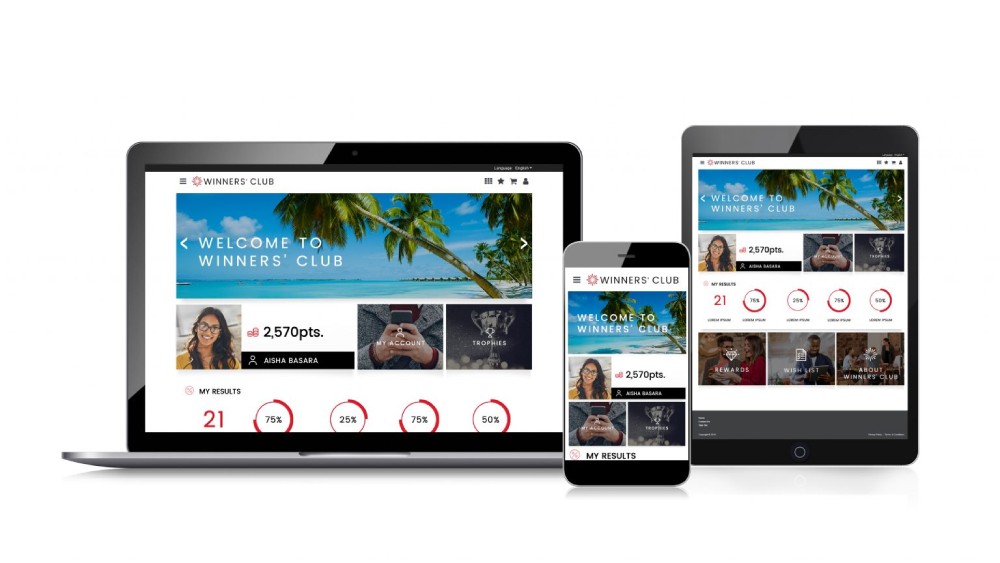Employee incentives are rewards or benefits offered by organisations to motivate and encourage their staff to achieve specific goals, enhance performance, and contribute positively to the overall success of the company. These incentives can take various forms, such as monetary rewards, recognition, professional development opportunities, and other tangible benefits. Incentives play a crucial role in fostering employee engagement, boosting morale, and creating a positive work environment.
Employee incentives are more than just a means of recognising and rewarding hard work they also serve as powerful tools for driving measurable outcomes that positively impact an organisation’s success. Whether through increased productivity, goal achievement, or enhanced job satisfaction, the impact of incentives can be quantified and monitored to ensure their effectiveness in motivating and engaging staff.
Our employee incentive programmes have data at their heart, ensuring we measure every interaction from an employee, which in turn allows us to measure their performance and achievements and reward them accordingly. Our experienced team can offer guidance on how to best structure employee incentives to ensure they are fully measurable and deliver return on investment.

How incentives motivate employees
Incentives play a crucial role in motivating employees by aligning their personal goals with the overall objectives of the organisation. A well-structured employee incentive programme can boost morale, improve performance, and contribute to the overall success of a business.
How do incentives motivate employees?
The key is to align incentives with organisational goals, individual preferences, and a culture of appreciation, fostering a motivated and engaged workforce.
Incentives motivate employees through various psychological and practical mechanisms, tapping into individuals’ desires, needs, and aspirations.
Here are 10 ways in which incentives drive motivation among employees:
- Recognition and Appreciation: Incentives often include public recognition or acknowledgment of an employee’s achievements. This satisfies the intrinsic need for appreciation and boosts morale, making employees feel valued and respected for their contributions.
- Tangible Rewards: Monetary rewards, bonuses, or other tangible benefits serve as extrinsic motivators. These incentives provide employees with concrete, measurable outcomes for their efforts, linking performance to financial or material gains.
- Goal Alignment: Well-designed incentive programmes align individual or team goals with organisational objectives. When employees see a clear connection between their efforts and the overall success of the company, they are more motivated to contribute to the achievement of those goals.
- Sense of Accomplishment: Achieving specific targets or milestones is intrinsically rewarding. Incentives tied to accomplishment provide employees with a sense of pride and satisfaction in their work, fostering a positive attitude towards future challenges.
- Career Development Opportunities: Incentives can include opportunities for professional growth, skill development, or career advancement. The promise of learning new skills or climbing the career ladder motivates employees to invest time and effort in their roles.
- Healthy Competition: Incentives often create a sense of healthy competition among employees. The desire to outperform peers and be recognised for exceptional achievements can be a powerful motivator, leading to increased effort and dedication.
- Job Satisfaction and Well-being: Incentives contribute to overall job satisfaction by addressing both financial and non-financial aspects of well-being. Employees who feel content in their roles and appreciated by their employers are more likely to be motivated and engaged.
- Increased Productivity: The prospect of rewards or recognition serves as a direct motivator for increased productivity. When employees know that their hard work will be acknowledged or rewarded, they are more likely to put in extra effort to accomplish tasks efficiently.
- Sense of Fairness and Equity: Fair and transparent incentive programmes create a sense of equity among employees. Knowing that rewards are distributed based on merit and performance fosters a positive work environment and motivates employees to strive for excellence.
- Psychological Ownership: Incentives create a sense of psychological ownership, making employees feel more connected to their work and the organisation’s success. This emotional investment motivates individuals to go above and beyond their basic job requirements.
By appealing to various aspects of human motivation, well-designed incentive programmes can significantly enhance employee engagement and performance.
An employee incentive programme may be structured to:
- Achieve an increased sales volume or spend target
- Widen the customer base and number of accounts
- Improve employee knowledge of products and services
- Provide increased learning and development opportunities
- Increase productivity and performance in key business areas
- Attract and retain staff and reduce turnover rates
Examples of the type of incentives FMI can help organise to motivate employees
Reengaging and remotivating call centre staff
During the COVID-19 pandemic we were approached by a telecommunications client to design an employee incentive programme that would engage staff whilst they acclimatised to their new working from home set-ups. The programme objectives were to not only engage staff from a product and brand perspective but in terms of mental well-being during such a difficult period. We designed an employee incentive platform that helped build a community for employees, encouraging them to interact with one another, whilst rewarding them for participating and interacting with the daily content published.
Driving engagement with a programme refresh
We were approached by one of the world’s leading frozen food manufacturers, to refresh their existing employee incentive programme to reinvigorate their large employee base across Europe. A fresh identity, combined with new programme communications and a switch up on reward offerings, drove employee engagement with their reward and recognition scheme. Staff were rewarded quarterly with an annual awards ceremony to celebrate their successes with all employees across Europe.
Communicating brand values and customer care
Following a period of consultancy with an automotive brand, we launched an employee incentive programme across Eastern Europe to encourage employees to care about high levels of customer care. Built to enhance employee effectiveness it increased involvement from dealerships to enable the brand to communicate their brand strategy. With sales performance, recognition and team rewards the employee programme drove loyalty amongst key staff with a 360° approach to engagement.
Measuring the effectiveness of your incentives
Measuring the effectiveness of employee incentives is crucial to ensure that they are achieving their intended goals and providing a return on investment for the organisation. Here are some key methods and metrics to measure the effectiveness of your incentives:
- Goal Achievement: Evaluate the extent to which employees are meeting or exceeding performance goals that are directly linked to the incentives. If the incentive programme is tied to specific objectives, tracking the achievement of these goals through an online dashboard provides a clear measure of success.
- Key Performance Indicators (KPIs): Identify relevant KPIs that align with the objectives of your incentive programme. These could include sales figures, training targets, customer satisfaction scores, or other metrics specific to your industry or organisational goals.
- Employee Surveys and Feedback: Gather feedback from employees through surveys to gauge their perception of the incentive programme. Assess whether employees find the incentives motivating and whether they believe the rewards are fair and aligned with their efforts.
- Retention Rates: Monitor employee retention rates to determine if the incentive programme has a positive impact on keeping valuable talent within the organisation. A decrease in turnover rates can indicate that employees are satisfied and motivated by the incentives.
- Productivity Metrics: Analyse productivity metrics, such as output per employee or project completion rates, to determine if there is a noticeable increase associated with the implementation of the incentive programme.
- Cost-Benefit Analysis: Conduct a cost-benefit analysis to compare the expenses associated with the incentive programme against the achieved results. Assess whether the return on investment justifies the resources allocated to the programme.
- Quality of Work: Examine the quality of work produced by employees during the incentive period. Improved quality may be a result of heightened motivation and commitment to achieving performance-related goals.
- Peer and Managerial Observations: Seek input from peers and managers regarding changes in employee behaviour, teamwork, and overall work atmosphere. Observations from those working closely with incentivised individuals can provide valuable insights into the programme’s impact.
- Employee Participation Rates: Measure the level of participation in the incentive programme. Low participation rates may indicate a lack of interest or understanding, while high participation rates suggest engagement and enthusiasm.
- Employee Well-being: Consider the impact of incentives on employee well-being and job satisfaction. Assess factors such as stress levels, work-life balance, and overall job satisfaction to ensure that incentives are contributing positively to the work environment.
- Benchmarking Against Industry Standards: Compare the performance and outcomes of your incentive programme against industry benchmarks and best practices. This can provide valuable insights into how your programme stacks up against similar initiatives in your sector.

Employee incentives with FMI
As an experienced employee incentive company, we are focused on engaging employees and increasing business performance for our clients. Each incentive programme we design and develop is built with the organisation and employees in mind to ensure we provide a bespoke solution that gets the utmost out of their investment.
Our team of incentive experts can help define the strategy and objectives of your incentive, through to final design, build and launch. We work collaboratively with clients to ensure the employee incentive programme is underpinned with excellent communications and the right level of rewards to generate the desired behaviours.
Employee incentives with FMI can include:
- Employee incentive strategy and consultancy
- Incentive programme identity and design
- Incentive mobile optimised website
- Employee recognition scheme
- Employee rewards (e-codes, vouchers, experiences and Mastercard)
- Measurable reporting dashboards
- Account management and customer service
If you are seeking an agency partner to help design measurable ways to incentivise your staff, then contact us. We know the types of rewards to offer employees, we understand local markets and cultural nuances, and have a global supplier network that can accommodate even the most complex of incentive requirements. Our experts will ask the right questions to help define your requirements and provide an engaging solution that will deliver return on investment.
Contact us below to discuss your employee incentive programme.












